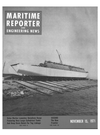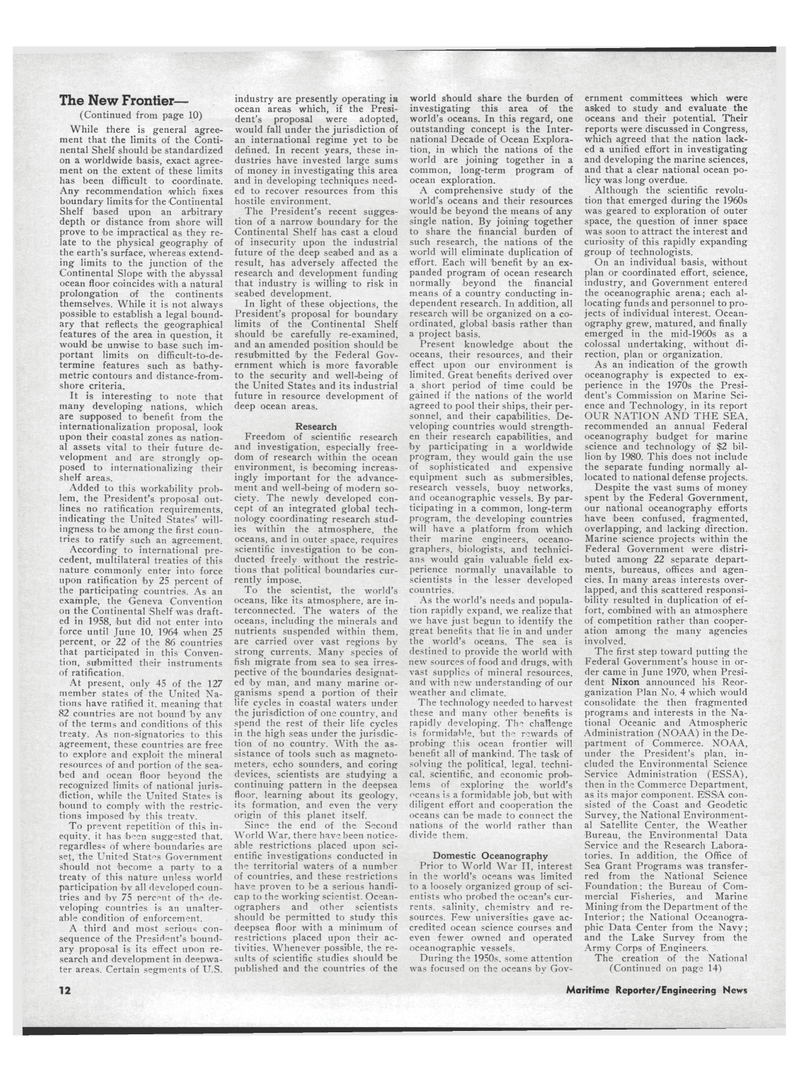
Page 10: of Maritime Reporter Magazine (November 15, 1971)
Read this page in Pdf, Flash or Html5 edition of November 15, 1971 Maritime Reporter Magazine
The New Frontier— (Continued from page 10)
While there is general agree- ment that the limits of the Conti- nental Shelf should he standardized on a worldwide basis, exact agree- ment on the extent of these limits has been difficult to coordinate.
Any recommendation which fixes boundary limits for the Continental
Shelf based upon an arbitrary depth or distance from shore will prove to 'be impractical as they re- late to the physical geography of the earth's surface, whereas extend- ing limits to the junction of the
Continental Slope with the abyssal ocean floor coincides with a natural prolongation of the continents themselves. While it is not always possible to establish a legal bound- ary that reflects the geographical features of the area in question, it would be unwise to base such im- portant limits on difficult-to-de- termine features such as bathy- metric contours and distance-from- shore criteria.
It is interesting to note that many developing nations, which are supposed to benefit from the internationalization proposal, look upon their coastal zones as nation- al assets vital to their future de- velopment and are strongly op- posed to internationalizing their shelf areas.
Added to this workability prob- lem, the President's proposal out- lines no ratification requirements, indicating the United States' will- ingness to be among the first coun- tries to ratify such an agreement.
According to international pre- cedent, multilateral treaties of this nature commonly enter into force upon ratification by 25 percent of the participating countries. As an example, the Geneva Convention on the Continental Shelf was draft- ed in 1958, but did not enter into force until June 10. 1964 when 25 percent, or 22 of the 86 countries that participated in this Conven- tion, submitted their instruments of ratification.
At present, only 45 of the 127 member states of the United Na- tions have ratified it, meaning that 82 countries are not bound by anv of the terms and conditions of this treaty. As non-signatories to this agreement, these countries are free to explore and exploit the mineral resources of and portion of the sea- bed and ocean floor beyond the recognized limits of national juris- diction, while the United States is bound to comply with the restric- tions imposed by this treaty.
To prevent repetition of this in- equity. it has been suggested that, regardless of where boundaries are set, the United States Government should not become a party to a treaty of this nature unless world participation by all developed coun- tries and by 75 percent of the de- veloping countries is an unalter- able condition of enforcement.
A third and most serious con- sequence of the President's bound- ary proposal is its effect unon re- search and development in deepwa- ter areas. Certain segments of U.S. industry are presently operating in ocean areas which, if the Presi- dent's proposal were adopted, would fall under the jurisdiction of an international regime yet to be defined. In recent years, these in- dustries have invested large sums of money in investigating this area and in developing techniques need- ed to recover resources from this hostile environment.
The President's recent sugges- tion of a narrow boundary for the
Continental Shelf has cast a cloud of insecurity upon the industrial future of the deep seabed and as a result, has adversely affected the research and development funding that industry is willing to risk in seabed development.
In light of these objections, the
President's proposal for boundary limits of the Continental Shelf should be carefully re-examined, and an amended position should be resubmitted by the Federal Gov- ernment which is more favorable to the security and well-being of the United States and its industrial future in resource development of deep ocean areas.
Research
Freedom of scientific research and investigation, especially free- dom of research within the ocean environment, is becoming increas- ingly important for the advance- ment and well-being of modern so- ciety. The newly developed con- cept of an integrated global tech- nology coordinating research stud- ies within the atmosphere, the oceans, and in outer space, requires scientific investigation to be con- ducted freely without the restric- tions that political boundaries cur- rently impose.
To the scientist, the world's oceans, like its atmosphere, are in- terconnected. The waters of the oceans, including the minerals and nutrients suspended within them, are carried over vast regions by strong currents. Many species of fish migrate from sea to sea irres- pective of the boundaries designat- ed by man, and many marine or- ganisms spend a portion of their life cycles in coastal waters under the jurisdiction of one country, and spend the rest of their life cycles in the high seas under the jurisdic- tion of no country. With the as- sistance of tools such as magneto- meters, echo sounders, and coring devices, scientists are studying a continuing pattern in the deepsea floor, learning about its geology, its formation, and even the very origin of this planet itself.
Since the end of the Second
World War, there have been notice- able restrictions placed upon sci- entific investigations conducted in the territorial waters of a number of countries, and these restrictions have proven to be a serious handi- cap to the working scientist. Ocean- ographers and other scientists should be permitted to study this deepsea floor with a minimum of restrictions placed upon their ac- tivities. Whenever possible, the re- sults of scientific studies should be published and the countries of the world should share the burden of investigating this area of the world's oceans. In this regard, one outstanding concept is the Inter- national Decade of Ocean Explora- tion, in which the nations of the world are joining together in a common, long-term program of ocean exploration.
A comprehensive study of the world's oceans and their resources would be beyond the means of any single nation. By joining together to share the financial burden of such research, the nations of the world will eliminate duplication of effort. Each will benefit 'by an ex- panded program of ocean research normally beyond the financial means of a country conducting in- dependent research. In addition, all research will be organized on a co- ordinated, global basis rather than a project basis.
Present knowledge about the oceans, their resources, and their effect upon our environment is limited. Great benefits derived over a short period of time could be gained if the nations of the world agreed to pool their ships, their per- sonnel, and their capabilities. De- veloping countries would strength- en their research capabilities, and by participating in a worldwide program, they would gain the use of sophisticated and expensive equipment such as submersibles, research vessels, buoy networks, and oceanographic vessels. By par- ticipating in a common, long-term program, the developing countries will have a platform from which their marine engineers, oceano- graphers, biologists, and technici- ans would gain valuable field ex- perience normally unavailable to scientists in the lesser developed countries.
As the world's needs and popula- tion rapidly expand, we realize that we have just begun to identify the great benefits that lie in and under the world's oceans. The sea is destined to provide the world with new sources of food and drugs, with vast supplies of mineral resources, and with new understanding of our weather and climate.
The technology needed to harvest these and many other benefits is rapidly developing. The challenge is formidable, but the rewards of probing this ocean frontier will benefit all of mankind. The task of solving the political, legal, techni- cal, scientific, and economic prob- lems of exploring the world's oceans is a formidable job, but with diligent effort and cooperation the oceans can be made to connect the nations of the world rather than divide them.
Domestic Oceanography
Prior to World War II, interest in the world's oceans was limited to a loosely organized group of sci- entists who probed the ocean's cur- rents. salinity, chemistrv and re- sources. Few universities gave ac- credited ocean science courses and even fewer owned and operated oceanographic vessels.
During the 1950s, some attention was focused on the oceans bv Gov- ernment committees which were asked to study and evaluate the oceans and their potential. Their reports were discussed in Congress, which agreed that the nation lack- ed a unified effort in investigating and developing the marine sciences, and that a clear national ocean po- licy was long overdue.
Although the scientific revolu- tion that emerged during the 1960s was geared to exploration of outer space, the question of inner space was soon to attract the interest and curiosity of this rapidly expanding group of technologists.
On an individual basis, without plan or coordinated effort, science, industry, and Government entered the oceanographic arena; each al- locating funds and personnel to pro- jects of individual interest. Ocean- ography grew, matured, and finally emerged in the mid-1960s as a colossal undertaking, without di- rection, plan or organization.
As an indication of the growth oceanography is expected to ex- perience in the 1970s the Presi- dent's Commission on Marine Sci- ence and Technology, in its report
OUR NATION AND THE SEA, recommended an annual Federal oceanography budget for marine science and technology of $2 bil- lion by 1980. This does not include the separate funding normally al- located to national defense projects.
Despite the vast sums of money spent by the Federal Government, our national oceanography efforts have been confused, fragmented, overlapping, and lacking direction.
Marine science projects within the
Federal Government were distri- buted among 22 separate depart- ments, bureaus, offices and agen- cies. In many areas interests over- lapped, and this scattered responsi- bility resulted in duplication of ef- fort, combined with an atmosphere of competition rather than cooper- ation among the many agencies involved.
The first step toward putting the
Federal Government's house in or- der came in June 1970, when Presi- dent Nixon announced his Reor- ganization Plan No. 4 which would consolidate the then fragmented programs and interests in the Na- tional Oceanic and Atmospheric
Administration (NOAA) in the De- partment of Commerce. NOAA, under the President's plan, in- cluded the Environmental Science
Service Administration (ESSA), then in the Commerce Department, as its major component. ESSA con- sisted of the Coast and Geodetic
Survey, the National Environment- al Satellite Center, the Weather
Bureau, the Environmental Data
Service and the Research Labora- tories. In addition, the Office of
Sea Grant Programs was transfer- red from the National Science
Foundation: the Bureau of Com- mercial Fisheries, and Marine
Mining from the Department of the
Interior; the National Oceanogra- phic Data Center from the Navy; and the Lake Survey from the
Army Corps of Engineers.
The creation of the National (Continued on page 14) 12 Maritime Reporter/Engineering News

 9
9

 11
11
